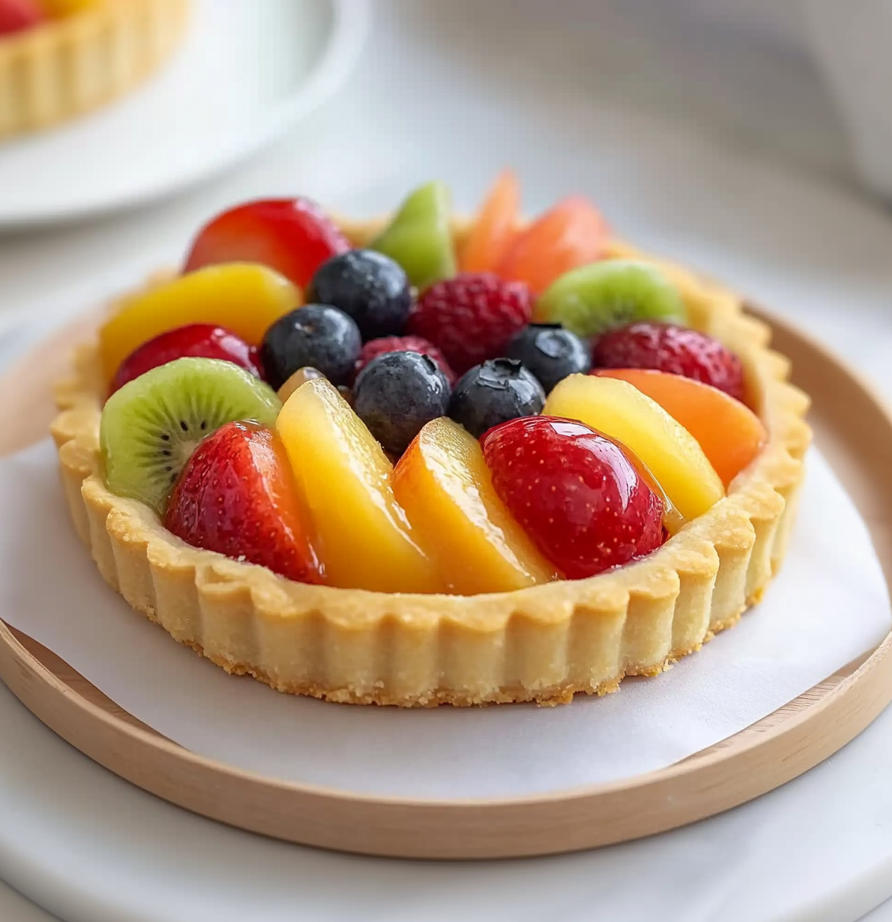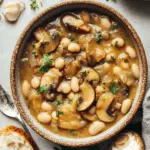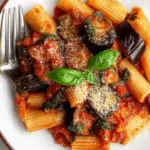This classic Fruit Tart features a crisp, buttery pastry shell filled with creamy vanilla custard and topped with an array of fresh fruits. It’s a delightful dessert that combines various textures and flavors, making it perfect for spring and summer gatherings.
Full Recipe:
Ingredients
For the Tart Shell:
- 1 cup (226g) unsalted butter, cold and cubed
- 1 2/3 cups (160g) powdered sugar
- 1/4 teaspoon salt
- 1 teaspoon vanilla extract
- 6 large egg yolks
- 3 1/3 cups (400g) all-purpose flour
For the Pastry Cream:
- 2 cups (480ml) whole milk
- 1/2 vanilla bean, split lengthwise (or 1 teaspoon vanilla extract)
- 6 large egg yolks
- 2/3 cup (135g) granulated sugar
- 1/4 cup (32g) cornstarch
- 1 tablespoon (14g) unsalted butter
For Assembly:
- Assorted fresh fruits (e.g., strawberries, blueberries, kiwi, raspberries)
- 1/2 cup (160g) apricot jam
- 1 tablespoon water
Directions
Prepare the Tart Shell:
- In a stand mixer fitted with a paddle attachment, combine the cold butter, powdered sugar, salt, and vanilla extract. Mix until homogeneous.
- Add the egg yolks and mix until combined.
- Add the flour and mix until the dough comes together.
- Roll the dough between two sheets of lightly floured parchment paper to about 1/4-inch thickness. Chill for at least 1 hour.
- Preheat the oven to 320°F (160°C).
- Line tart pans with the chilled dough, trimming excess.
- Bake for about 12 minutes or until lightly golden. Let cool completely.
Make the Pastry Cream:
- In a medium saucepan, heat the milk and vanilla bean over medium heat until it just begins to boil. Remove from heat and let it infuse for 15 minutes.
- In a separate bowl, whisk together the egg yolks and granulated sugar until light and fluffy.
- Add the cornstarch to the egg mixture and whisk until smooth.
- Gradually whisk in the hot milk mixture.
- Return the mixture to the saucepan and cook over medium-high heat, whisking constantly until it thickens and comes to a boil.
- Remove from heat and stir in the butter.
- Transfer the pastry cream to a bowl, cover with plastic wrap pressed directly onto the surface, and chill for at least 2 hours.
Assemble the Fruit Tart:
- Fill the cooled tart shell with the chilled pastry cream, smoothing the top.
- Arrange the fresh fruits on top of the pastry cream in a decorative pattern.
- In a small saucepan, heat the apricot jam and water until melted. Strain if necessary.
- Brush the glaze over the fruits to give them a shiny finish.
- Refrigerate the tart until ready to serve.
Nutritional Facts (per serving, estimated)
- Calories: Approximately 300-350 kcal
- Carbohydrates: 35-45g
- Protein: 4-6g
- Fat: 15-20g
- Saturated Fat: 9-12g
- Cholesterol: 100-150mg
- Sodium: 50-100mg
- Fiber: 2-3g
- Sugar: 20-25g
The Origins and History of the Fruit Tart
Fruit tarts have a long and rich history dating back to European culinary traditions, particularly in France. The French pâtisserie scene has elevated the fruit tart into an art form, showcasing expert techniques in pastry making and presentation. Historically, tarts were made with simple, seasonal fruits, and the use of custard or pastry cream developed over time as a way to add richness and balance the tartness of the fruit. The concept spread worldwide, with regional variations appearing that use local fruits and flavor profiles, making the fruit tart a globally beloved dessert.
The Components That Make a Fruit Tart Special
The magic of a fruit tart lies in its distinct components working together:
-
The Tart Shell: Typically made from pâte sucrée, a sweet, buttery dough, the crust provides a firm yet tender base that holds the filling. The dough’s richness complements the freshness of the fruit, and its crisp texture contrasts beautifully with the smooth cream and juicy fruit topping.
-
The Pastry Cream: Also known as crème pâtissière, this custard is thick, silky, and flavored with vanilla. It acts as a luscious cushion for the fruit, adding sweetness and a creamy mouthfeel. The pastry cream must be perfectly cooked to avoid curdling or lumpiness, and its chilling time helps it set firmly enough to hold the fruit without melting or running.
-
Fresh Fruit Topping: The crowning glory of the tart is its fruit decoration. Using a mix of vibrant berries, kiwi, peaches, or other seasonal fruits not only adds color but also a range of flavors and textures—sweet, tart, juicy, and crisp. The arrangement of the fruit is often done with care to create visual appeal, sometimes in circular patterns or artistically layered designs.
-
The Glaze: A thin coat of apricot jam or a neutral glaze is brushed over the fruit to give it a beautiful shine and help preserve freshness. This step also prevents the fruit from drying out or browning, ensuring the tart remains visually appealing and delicious for longer.
Why the Fruit Tart is a Favorite Dessert
The fruit tart offers a sensory experience that appeals to many. Its combination of flavors—from the buttery crust and creamy custard to the fresh, often slightly tangy fruit—is satisfying and balanced. Unlike overly rich desserts, the fresh fruit topping provides a refreshing element that lightens the dish. The tart’s aesthetic appeal also makes it a showstopper at parties and celebrations, where appearance can be as important as taste.
Moreover, the fruit tart is customizable, allowing bakers and home cooks to showcase their creativity by choosing different fruits, experimenting with various crust recipes, or adding subtle flavor twists like citrus zest or liqueurs to the pastry cream.
Seasonal and Regional Variations
Depending on the season and location, the fruit tart can take on many delightful forms. In spring and summer, berries like strawberries, blueberries, and raspberries are popular choices, celebrated for their natural sweetness and bright colors. Autumn tarts might incorporate stone fruits like peaches or plums, and in some regions, tropical fruits such as mango or passion fruit are favored.
Regional adaptations also vary the base and filling. Some recipes include almond cream or frangipane underneath the fruit for extra flavor and texture. In other cultures, the tart might feature different types of dough—such as a puff pastry base or a shortbread crust. This diversity enriches the fruit tart’s reputation as a versatile and beloved dessert worldwide.
Health Considerations
While fruit tarts are undeniably indulgent, they also offer nutritional benefits through their fruit content. Fruits provide vitamins, antioxidants, and fiber, which contribute to overall health. The tart’s pastry cream and crust are rich in fats and sugars, so moderation is key when enjoying this dessert. For those seeking healthier versions, it is possible to modify the recipe by using whole-grain flours for the crust, reducing sugar in the custard, or focusing on a higher ratio of fresh fruit toppings.
Tips for Making the Perfect Fruit Tart
Achieving a perfect fruit tart requires attention to detail at each stage:
-
Ensuring the tart shell is evenly rolled and chilled helps prevent shrinking and cracking during baking.
-
Cooking the pastry cream slowly and whisking continuously avoids lumps and ensures a smooth texture.
-
Selecting ripe, fresh fruits at their peak ensures the best flavor and presentation.
-
Arranging the fruit artistically not only looks impressive but also balances flavors in each bite.
-
Applying a thin glaze preserves freshness and enhances the tart’s shine.
Pairing and Serving Suggestions
Fruit tarts can be enjoyed on their own or paired with complementary accompaniments. A dollop of freshly whipped cream or a scoop of vanilla ice cream adds richness. For a beverage pairing, light and fruity white wines or sparkling wines work well. Herbal teas or coffee also balance the sweetness of the tart.
Serving fruit tart chilled is ideal to maintain the firmness of the pastry cream and freshness of the fruit. It’s often presented as a centerpiece dessert at celebrations like birthdays, holidays, or weddings, thanks to its elegant appearance and universal appeal.
Conclusion
The fruit tart is more than just a dessert; it’s a celebration of texture, flavor, and color that brings joy to both the maker and the eater. Rooted in tradition yet endlessly adaptable, it combines simple ingredients in a sophisticated way. From its buttery crust to its creamy filling and fresh fruit topping, every element plays a vital role in creating a balanced and beautiful treat.






